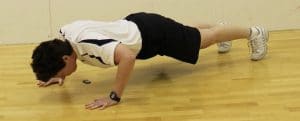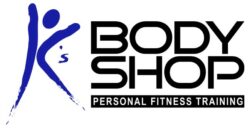Most of the new clients I see struggle to do a basic push-up correctly, yet they are frequently quick to want to move on to more challenging variations even though they aren’t ready. Men typically have more upper body strength than women, but push-ups are a total body exercise that actually rely more on core strength and stability than brute upper body force. We frequently need to address scapular stabilizers as well as trunk stabilizers before moving on to the bigger stuff. In the meantime, this means backing off to an easier version of the exercise until you can actually do it correctly. Yes, modified push-ups from the knees are an option. But what if even that is too difficult? And how do you know if you need to regress the exercise or you’re good to go?
Review Anatomy of a Push-Up
Correct Push-Up Technique
To ensure you are performing the push-up with good form, follow this checklist:
Chin is tucked and neck is in good alignment with the rest of the body. Eyes should be gazing between hands.
Hands should be slightly wider than shoulder width apart with palms flat on floor and fingers pointing forward.
Shoulder girdle (scapula) should be neutral. No shrugging, no winging.
Abdomen should be drawn in. Pelvis is neutral and in line with head and shoulders.
Hips, knees and feet are in alignment – hip width apart. Glutes are activated. Legs are straight.
Toes are tucked under so that you are on balls of feet.

To ensure you are performing the prone plank with good form, follow this checklist:
Chin is tucked and neck is in good alignment with the rest of the body. Eyes should be gazing between hands.
Forearms should be parallel to each other with elbows directly under shoulders. Hands should be shoulder width apart.
Shoulder girdle (scapula) should be neutral.
Abdomen should be drawn in. Pelvis is neutral and in line with head and shoulders.
Hips, knees and feet are in alignment – hip width apart. Glutes are activated. Legs are straight.
Toes are tucked under so that you are on balls of feet (easier to do without shoes).
– See more at: http://www.ksbodyshop.com/prone-plank-exercise-common-training-errors/#sthash.4cO9a8dk.dpuf
Common Push-Up Errors
Many of the common push-up errors are similar to errors I see with the prone plank exercise:
Reaching toward the floor with the chin, resulting in flexion of the cervical spine.
Allowing shoulders to sag so that the scapula wing. The problem with this common error is that you typically can’t tell if you’re doing it since you can’t see what your shoulder blades are doing behind your back.
Allowing trunk to sag.
Piking your hips so that your butt is up in the air. Also known as “tenting” because from the side, it resembles an A-frame style tent.
Not moving your body up and down as a single unit – it looks more like a wave.
To ensure you are performing the prone plank with good form, follow this checklist:
Chin is tucked and neck is in good alignment with the rest of the body. Eyes should be gazing between hands.
Forearms should be parallel to each other with elbows directly under shoulders. Hands should be shoulder width apart.
Shoulder girdle (scapula) should be neutral.
Abdomen should be drawn in. Pelvis is neutral and in line with head and shoulders.
Hips, knees and feet are in alignment – hip width apart. Glutes are activated. Legs are straight.
Toes are tucked under so that you are on balls of feet (easier to do without shoes).
– See more at: http://www.ksbodyshop.com/prone-plank-exercise-common-training-errors/#sthash.4cO9a8dk.dpuf
Review Prone Plank Exercise – Common Errors
Push-Up Regressions
The next step down from a full push-up is a modified push-up from the knees, though there are other ways to make a full push-up easier. This is especially important for folks who’ve had knee replacements and getting on the floor on their knees simply isn’t an option.
Wall push-ups are the easiest variation, and a common starting point with many of my older adult or shoulder post rehab clients. The next progression or substitute would be hands on a counter top.

Incline push-ups can be gradually progressed easily from a Smith rack, squat rack, or power cage in a gym – simply position the bar at the appropriate height for the intensity that you want and put your hands on the bar. The higher the bar, the easier the exercise. Step the bar down as you get stronger. Almost like an “upside down” bench press.
An in-home version of incline push-ups can be done on a staircase. With feet on the landing at the bottom of the stairs, hands go on the appropriate stair for the intensity that you want. As you get stronger, back your feet up and bring your hands down to the next stair.
Frequently we need to address smaller issues before even attempting push-ups. Things like rotator cuff, scapular stabilizers, spinal stabilizers, etc. If you can’t do the little things right, you’ll never be able to do the big things without compensation.
Get Assessed to Get Started
Push-ups are one of my favorite total body exercises and with proper technique and intensity, can be done by anyone. I have folks in their 90’s doing some variation of a push-up to help with their trunk and shoulder stability in addition to upper body strength and balance (yes, some of my variations require balance skills as well). If you’d like an assessment to check your current technique and learn which progression or regression would most benefit you, give me a call and we’ll get started! By checking your ego at the door and backing off to get the little things right, you’re more likely to avoid injury and increase your strength much faster.
Want to get FREE monthly fitness and nutrition tips delivered directly to your inbox? Access to early bird discounts and opportunities before the general public? Join for FREE now!

Pingback: Push-Ups Test Should Get Us Talking about Heart Health
Pingback: Gaining Inspiration From the 62-Year-Old Plank World Record Holder